Backcountry Tips- Survival Vest Component- Rope
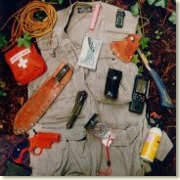 In my seven day survival vest, I carry many things, including 100 feet of thin strong nylon rope which I store in the back of my vest. Rope is very handy out into the bush. I have used it not only just for camping, but it has gotten me out of some very tight situations.
In my seven day survival vest, I carry many things, including 100 feet of thin strong nylon rope which I store in the back of my vest. Rope is very handy out into the bush. I have used it not only just for camping, but it has gotten me out of some very tight situations.
Out in the wilderness, you may not have a tent, or you may be unexpectedly caught in the woods overnight. With a rope, you can make a lean-to, or the frame for an emergency tent. You can tie the rope between two sturdy trees, and lean your tarp, some pieces of wood, or even your coat or other pieces of clothing to give you shelter for the evening.
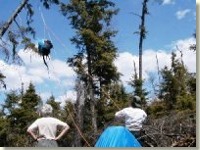 Rope can be very useful to store your food. When backpacking out in the bush, taking a bulky cooler along is not very practical. To protect your food supplies from animals and insects, you can tie one end of the rope to a stick, throw the stick over a large tree branch and tie your food supplies to the other end of the rope. Then you can hoist your food supplies high off the ground so that animals, especially bears, cannot get into them.
Rope can be very useful to store your food. When backpacking out in the bush, taking a bulky cooler along is not very practical. To protect your food supplies from animals and insects, you can tie one end of the rope to a stick, throw the stick over a large tree branch and tie your food supplies to the other end of the rope. Then you can hoist your food supplies high off the ground so that animals, especially bears, cannot get into them.
Another situation that you may find yourself in is that you may find yourself on one side of a lake or a wide river, and swimming across may not be an option. With your trusty rope, you may be able to collect or to cut enough wood to build a raft using the rope to tie the logs together to ferry you across the water.
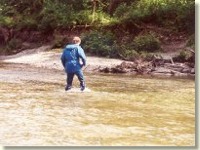 Rope is also useful in crossing smaller creeks. When I come to a very turbulent creek, and I’m not sure if I can get across it safely, then there are two ways that I use to get across. First, I try to find a large pole, and lean into it going across the creek to steady myself. If no poles are available, or if the water looks too turbulent, I take my rope, tie it to a large stick, and throw it to the other side, where it should catch among the trees or the rocks. I may have to throw a number of times before it snags on something solid. Then I tie the other end of the rope around my waist, and pull myself hand over hand on the rope to the other side. Remember, always keep the rope taut so that the rope does not loosen, or the stick may become loose and fall back into the river.
Rope is also useful in crossing smaller creeks. When I come to a very turbulent creek, and I’m not sure if I can get across it safely, then there are two ways that I use to get across. First, I try to find a large pole, and lean into it going across the creek to steady myself. If no poles are available, or if the water looks too turbulent, I take my rope, tie it to a large stick, and throw it to the other side, where it should catch among the trees or the rocks. I may have to throw a number of times before it snags on something solid. Then I tie the other end of the rope around my waist, and pull myself hand over hand on the rope to the other side. Remember, always keep the rope taut so that the rope does not loosen, or the stick may become loose and fall back into the river.
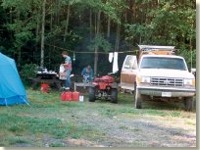 I remember that one winter’s day I was hiking with my youngest son Darin and my wife, looking at a real estate deal in Northern B.C. We had accessed the property by a four-wheel drive truck on a remote snowy dirt road, and we were over 100 miles away from the nearest town. We were quite a ways back in the bush and we were running out of daylight. We were unprepared to make an emergency camp, as there was a foot of snow on the ground, and the temperature was at least -28 Celcius. We had spent all day looking at this property, and on our way back to the vehicle, we came to a lake which hadn’t quite frozen over yet because of the foot of snow covering the ice.
I remember that one winter’s day I was hiking with my youngest son Darin and my wife, looking at a real estate deal in Northern B.C. We had accessed the property by a four-wheel drive truck on a remote snowy dirt road, and we were over 100 miles away from the nearest town. We were quite a ways back in the bush and we were running out of daylight. We were unprepared to make an emergency camp, as there was a foot of snow on the ground, and the temperature was at least -28 Celcius. We had spent all day looking at this property, and on our way back to the vehicle, we came to a lake which hadn’t quite frozen over yet because of the foot of snow covering the ice.
We could not walk around the lake because it was getting too dark, so we had to take a chance and walk across it or spend the night in the bush.
I wouldn’t have even attempted to cross this lake if I hadn’t carried my 100 feet of rope with me. Here’s how we crossed a semi-frozen lake, but I do NOT recommend that anyone else ever do this, even in an emergency. I cut my rope into two 50 foot pieces, and tied one around Darin and one around my wife. Darin took the lead, and I followed in his footsteps, holding his rope at the other end. My wife followed me at a cautious distance, walking in our footsteps, and dragging her rope behind her. Because the ice was not completely frozen, Darin fell through the ice a couple of times. The minute the ice began to break, I would dig in my heels and pull on the rope to get him back out. With me holding the other end of the rope, Darin was able to pull himself out, only getting wet to his waist. We were able to get across the lake and walked at a quick pace back to the truck, where we got Darin into some warmer dry clothes. That rope really got us out of that tough situation.
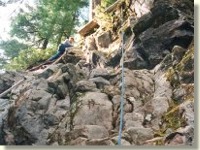 Rope is also useful in a rescue mission. When I was young and hunting in mountainous terrain, I learned that is was very easy climbing up a steep mountainside. The problem is when you try to climb back down again, because you can’t see where the cracks are in the cliff in which to put your feet. While I never had a problem with this, one of my buddies on a hunting trip got stuck on a cliff, panicked, and froze on a ledge halfway up a steep mountainside. He could not descend any further. I had to climb back down to our boat to get a large coil of rope that I always carried for the boat. Then I had to hike to the top of that bluff, lowered the rope down to my buddy and pulled him up the cliff. We then found an alternate and easier way down. After that episode, I always made certain I carried a length of rope with me.
Rope is also useful in a rescue mission. When I was young and hunting in mountainous terrain, I learned that is was very easy climbing up a steep mountainside. The problem is when you try to climb back down again, because you can’t see where the cracks are in the cliff in which to put your feet. While I never had a problem with this, one of my buddies on a hunting trip got stuck on a cliff, panicked, and froze on a ledge halfway up a steep mountainside. He could not descend any further. I had to climb back down to our boat to get a large coil of rope that I always carried for the boat. Then I had to hike to the top of that bluff, lowered the rope down to my buddy and pulled him up the cliff. We then found an alternate and easier way down. After that episode, I always made certain I carried a length of rope with me.
This trick saved my son Dean and myself on our annual survival hunting expedition. While in the middle of a multi-day hiking expedition in the bush, I had gone into hypothermia on a previous night, and I was in very weak condition. We were backpacking to our main camp, and we came to some very steep cliffs. I did not have the energy to find a trail around this cliff. We had to lower our packsacks to the bottom of the cliff using our 100 feet of rope, then we lowered each other using this rope. In this way, we got down to the bottom and continued on our way to our main base.
There are many more uses for the 100 feet of rope in my survival vest, and I will explain more of them at a later date. Watch www.niho.com for more tips on how I use my survival vest.
Contact Information: #200 - 313 Sixth Street, New Westminster, BC V3L 3A7 CANADA
Telephone: 604-606-7900 | Email: [email protected]
Copyright © 2012 Niho Land & Cattle Company. All rights reserved. | Privacy Policy | Terms of Use | Webmaster

